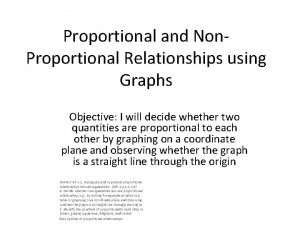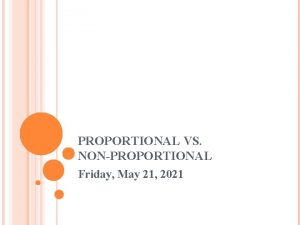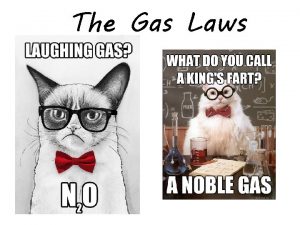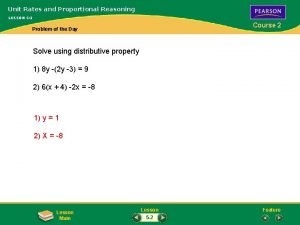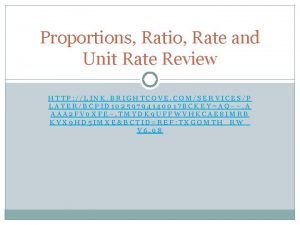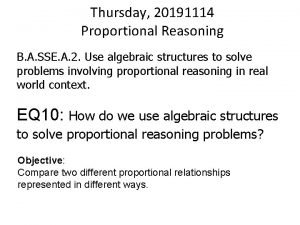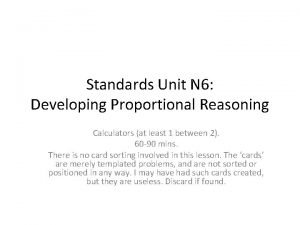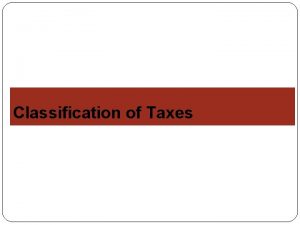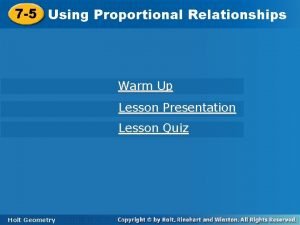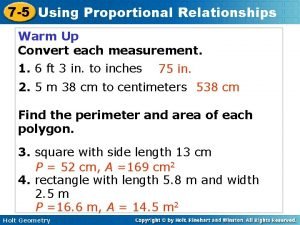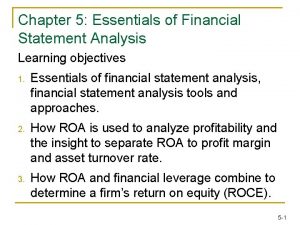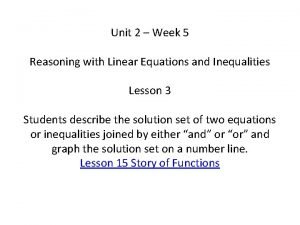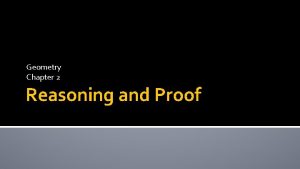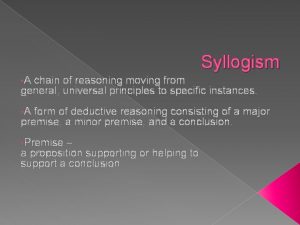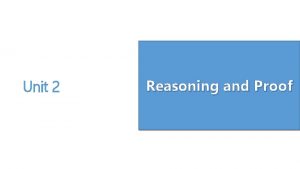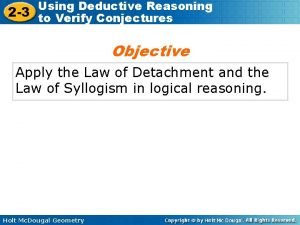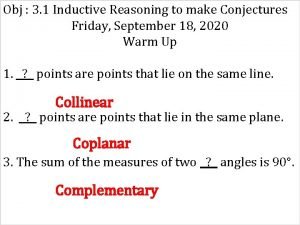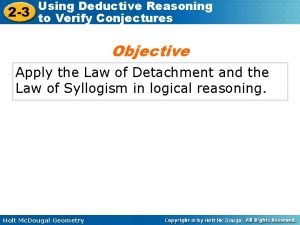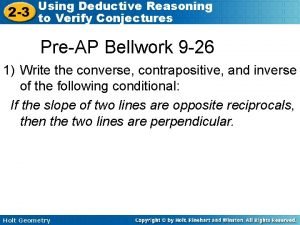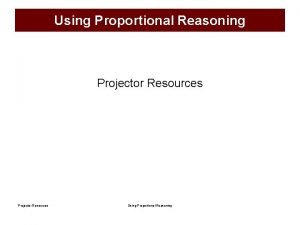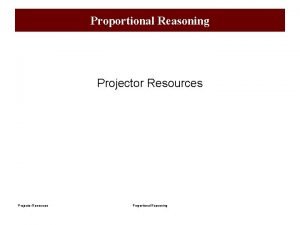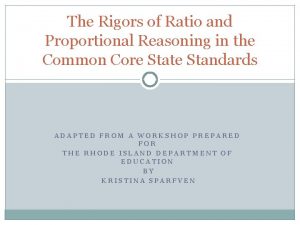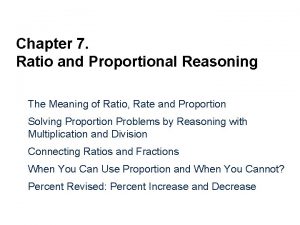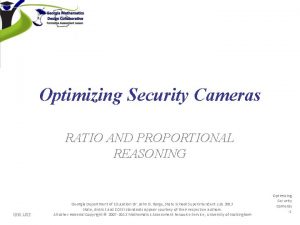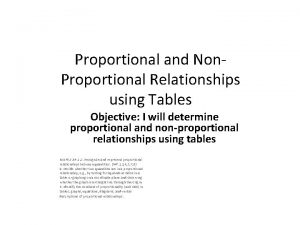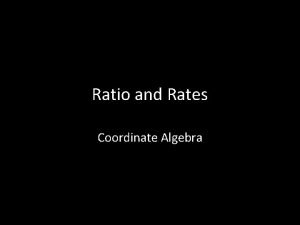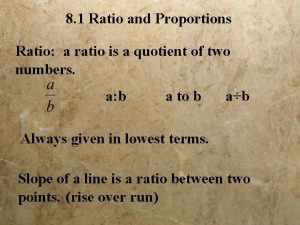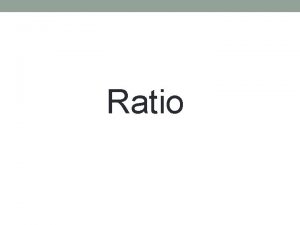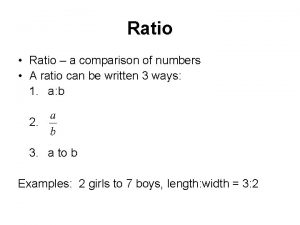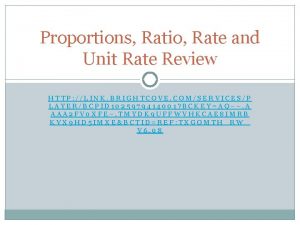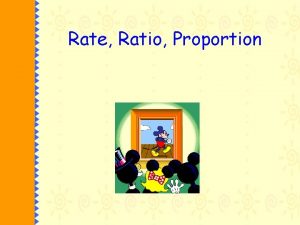Unit 2 Rate Ratio and Proportional Reasoning Using








































- Slides: 40

Unit 2: Rate, Ratio and Proportional Reasoning Using Equivalent Fractions


Standards: Understand ratio concepts and use ratio reasoning to solve problems. MCC 6. RP. 1 Understand the concept of a ratio and use ratio language to describe a ratio relationship between two quantities. MCC 6. RP. 2 Understand the concept of a unit rate a/b associated with a ratio a: b with b ≠ 0 (b not equal to zero), and use rate language in the context of a ratio relationship. MCC 6. RP. 3 Use ratio and rate reasoning to solve real-world and mathematical problems, e. g. by reasoning about tables of equivalent ratios, tape diagrams, double number line diagrams, or equations. MCC 6. RP. 3 b Solve unit rate problems including those involving unit pricing and constant speed.

Essential Questions: • What kinds of problems can I solve by using ratios? • What are rates? What are some examples of unit rates? • How are ratios and rates similar and different? Can I give examples • What information do I get when I compare two numbers using a

Content Objective: q I can communicate relationships between two quantities using ratio notation and language. I can determine unit rates from given ratios. q I can find the unit rate when given a ratio. Language Objective: q I can verbally explain to a partner what a rate is and why it is part of the ratio “family. ”

5 dogs Quantity: is an amount that can be counted or measured. Ratio: compares quantities that share a fixed, multiplicative relationship. Unit Ratio: are ratios written as some number to 1. LOTS: Language of the Standards

Rate: A comparison of two quantities that have different units of measure. Rational number: A number that can be written as a/b where a and b are integers, but b is not equal to 0.

Ratios and Rates Task: Write each ratio using the other two ways: 1. The ratio of 3 inches to 20 feet. 2. The ratio of 26 students: 1 class 3. The ratio of

Is 30 miles per hour a ratio? http: //learnzillion. co m/lessons/839 understand-ratesas-a-type-of-ratio

In this lesson you will learn how rates are part of the ratio family by reviewing the qualities of a ratio.

Let’s Review A ratio is a comparison of two or more quantities that are related. Part – to – Part – to. Total Rates

A Common Mistake comparison of two or more quantities 3 miles per 2 hours vs. 3 boys to 2 girls What is the difference?

Core Lesson Common Rates miles per gallon miles per hour price per pound Rates are ratios that compare two or more quantities of different measures.

Core Lesson boys to girls miles per hour distance time gender Rates are ratios that compare two or more quantities of different measures

Core Lesson Read “per” as “for every” 3 miles per 2 hours I traveled 3 miles for every 2 hours that passed. For every 3 miles traveled, it took 2 hours For every 2 hours that passed, I traveled 3 miles.

Core Lesson 3 miles per 2 hours miles 3 6 9 hours 2 4 6 Rates, like ratios, have a constant pattern.

In this lesson you have learned how rates are part of the ratio family by reviewing the qualities of a ratio.

http: //learnzillion. com/lessons/842 -defineunit-rate-using-double-number-line Are the speeds 30 miles per 3 hours and 10 miles per hour the same?

In this lesson you will learn to define a unit rate as a special kind of rate using a double number line.

Let’s Review Rates are ratios that compare two or more quantities of different measures. miles per gallon miles per hour price per pound

A Common Mistake 1 30 miles per hour 30 miles for every 1 hour What are the two quantities?

Core Lesson A unit rate is a rate where a quantity is always being compared to one of another quantity.

Core Lesson A car travels at a speed of 30 miles per 3 hours. miles 0 10 20 30 0 1 2 3 hours 10 miles per hour or 10 miles per 1 hour

Core Lesson miles 0 10 20 30 40 50 60 0 1 2 3 4 5 6 hours A unit rate is an equivalent, simplified rate.

Guided Practice George mowed twelve lawns in four hours. What unit rate properly expresses this rate?

In this lesson you have learned to define a unit rate as a special kind of rate by using a double number line.

When the denominator of a rate is 1, we call the rate a unit rate. We usually use the key word per or the division symbol / to indicate a unit rate. For example: If a student earns $7. 65 per hour, it is the same as $7. 65/hour, and means $7. 65 for every hour of work. Find the unit rate for the following: 4. 120 eggs from 20 chickens 5. $55 for 20 people

http: //learnzillion. com/lessons/841 -createunit-rate-using-tape-diagram How do you simplify a rate to its unit rate?

In this lesson you will learn to create a unit rate by using a tape diagram.

Let’s Review A unit rate is a rate where a quantity is always being compared to one of another quantity. 1 30 miles per hour

A Common Mistake You ran at a speed of 20 minutes per 2 miles. 10 minutes per mile! mile per minute

Core Lesson Jo walked 8 miles in 2 hours. What is her unit rate of speed? miles hours

Core Lesson Jo walks at a speed of 1 4 hour per miles hours Jo walks at a speed of 4 miles per hour.

In this lesson you have learned to create a unit rate by using a tape diagram.

Guided Practice A car travels at a speed of 15 miles in 3 hours. What are its unit rates of speed?

6. 250 miles in 4 hours 7. 60 feet in 4 minutes 8. 48 books for 16 students 9. 56 children from 14 families

Unit rates can also be used to solve problems. 10. Which is the better deal: 8 ounces of shampoo for $0. 99 or 12 ounces for $1. 47? 11. Which is the better deal: 3 cans of soda for $1. 27 or 5 cans of soda for $1. 79? 12. Which is the better deal: 10 pounds of hamburger for $4. 99 or 5 pounds of hamburger for $2. 49?

13. Which is traveling faster: Traveling 300 miles in 5 hours or traveling 250 miles in 4 hours? 14. Which is traveling faster: Traveling 75 miles in 1 hour or traveling 280 miles in 3. 5 hours? 14. Which is traveling faster: Traveling 150 yards in 40 seconds or traveling 406 feet in 35 seconds?

Did I meet today’s objectives? Content Objective: q I can communicate relationships between two quantities using ratio notation and language. I can determine unit rates from given ratios. q I can complete decimal computations using addition, subtraction, multiplication and division. Language Objective: q I can verbally explain to a partner what a rate is and why it is part of the ratio “family. ”

Discuss with your partner what a rate is and why it is part of the ratio “family. ” Also, discuss what makes a unit rate unique. Closing
 Proportional and non proportional
Proportional and non proportional Inversely proportional and directly proportional
Inversely proportional and directly proportional Non proportional graph
Non proportional graph Nonproportional table
Nonproportional table Proportional graphs worksheet
Proportional graphs worksheet Indirectly proportional
Indirectly proportional Course 2 chapter 1 ratios and proportional reasoning
Course 2 chapter 1 ratios and proportional reasoning Unit rate proportions
Unit rate proportions Practice proportional reasoning with scale drawings
Practice proportional reasoning with scale drawings Proportional reasoning calculator
Proportional reasoning calculator Proportional reasoning calculator
Proportional reasoning calculator Inductive reasoning definition
Inductive reasoning definition Induction meaning in logic
Induction meaning in logic Deductive reasoning
Deductive reasoning What is inductive reasoning
What is inductive reasoning Deductive learning vs inductive learning
Deductive learning vs inductive learning Every quiz has been easy therefore the quiz will be easy
Every quiz has been easy therefore the quiz will be easy Inductive reasoning is reasoning based on patterns
Inductive reasoning is reasoning based on patterns Proportional tax rate
Proportional tax rate To find the height h of a dinosaur in a museum
To find the height h of a dinosaur in a museum Using proportional relationships
Using proportional relationships 7-5 using proportional relationships
7-5 using proportional relationships Using proportional relationships
Using proportional relationships Acid test ratio and quick ratio
Acid test ratio and quick ratio Phenotypic and genotypic ratio of dihybrid cross
Phenotypic and genotypic ratio of dihybrid cross Current ratio and quick ratio
Current ratio and quick ratio Unit 2 reasoning with linear equations and inequalities
Unit 2 reasoning with linear equations and inequalities Reasoning and proof unit test
Reasoning and proof unit test Chain syllogism
Chain syllogism Unit 2 logic and proof inductive reasoning
Unit 2 logic and proof inductive reasoning Unit 1 reasoning and proof answers
Unit 1 reasoning and proof answers 2-3 using deductive reasoning to verify conjectures
2-3 using deductive reasoning to verify conjectures Using inductive reasoning to make conjectures answers
Using inductive reasoning to make conjectures answers 2-3 using deductive reasoning to verify conjectures
2-3 using deductive reasoning to verify conjectures Using inductive reasoning to make conjectures
Using inductive reasoning to make conjectures 2-1 using inductive reasoning to make conjectures
2-1 using inductive reasoning to make conjectures Using inductive reasoning to make conjectures
Using inductive reasoning to make conjectures Using deductive reasoning to verify conjectures
Using deductive reasoning to verify conjectures Using deductive reasoning to verify conjectures
Using deductive reasoning to verify conjectures Using deductive reasoning to verify conjectures
Using deductive reasoning to verify conjectures Nominal v. real interest rates
Nominal v. real interest rates
